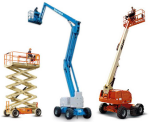
A boom lift, sometimes called a cherry picker or basket crane, is a piece of equipment which is used to lift people or equipment into the air usually for construction or maintenance jobs. Electrical contractors, telephone line contractors, and tree service contractors use this equipment most often, but are used for any aerial job. Attached to the boom or arm is either a bucket or platform where a person can easily stand while being hoisted. The boom lift rental cost depends largely on the type that you need.
There are several different types of boom lifts, each with particular benefits. A telescopic or stick boom lift has a long arm which can be raised and angled to reach the necessary height. An articulating boom lift, also called knuckle lift, is jointed in order to move the bucket or platform to the required height while navigating around obstacles such as trees or power lines. Some lifts can be towed behind a work truck and come attached to a turntable so that the boom can be rotated 360 degrees giving maximum accessibility.
There are two power sources available for boom lift equipment: electric and gas powered. Each has advantages depending on the application and the duration of the job. Outdoor equipment is usually powered by a diesel or propane generator while lifts designed for indoor use are usually battery powered.
What Is the Total Boom Lift Rental Cost?
1. The Rental Fee
Rental fees are determined by the type of equipment being rented and the rental period. For example, a daily rate for renting a 30 foot articulating boom lift could run from $175 to $200 a day while renting a long 135 foot articulating boom lift could run in excess of $1,500 a day. A lift is usually rented by the day, week, month, or year but rental companies will allow you to rent the equipment by the hour.
2. The Cost of Insurance
You need to insure the equipment while it is in your possession. This can be done though your own contractors equipment policy, if you have one. If you are insuring a boom lift through your own insurance program, be sure to ensure that your policy includes replacement cost valuation for leased, rented or borrowed equipment, that the per item limit is high enough to cover the value of the boom lift, and that coverage is in place for the equipment during transit. If you do not have contractors equipment insurance, the rental company will require that you purchase their damage waiver which usually costs 12%-15% of the total rental contract amount.
3. The Transportation Costs
While many equipment rental companies, include delivery in their rental fee, some do not. If you rent a small towable boom lift, it may be possible to pick up the equipment yourself thereby avoiding delivery fees. Otherwise, you should expect to pay an additional $100 for the delivery and pick-up fee.
Pros and Cons of Renting Versus Buying a Boom Lift
There are several advantages to renting boom equipment over buying one.
1. Choice of Boom Lift Types
By renting, you have a choice of many types and lengths to use depending on the needs of the job. One lift may be suitable for one job while another lift is better suited for another. Furthermore, you can assure that the equipment that you are using is not obsolete.
2. Proper Safety and Inspection Training for the Operator
Though OSHA does not require that boom lift operators to be certified, they do need to be trained in the proper and safe operation of the equipment. Improper use of a boom lift can result in property damage, bodily injury, or death. The equipment rental company will train your operator to correctly use the lift and how to complete a daily safety checklist inspection.
3. Avoid Maintenance and Inspection Costs
Boom lifts should be inspected every 3 months or 150 hours of use. They are required to be inspected annually by a qualified technician. If you rent a piece of equipment for a long period, you can arrange to have the inspections done by the rental company. If any deficiencies are found, the boom lift will be replaced with another.
4. Minimal Down Time When the Boom Lift Needs Repair
If the boom lift is malfunctioning, you can get a replacement from the dealer quickly and they will handle the repair costs. By renting the equipment, you can avoid expensive repair bills and costly construction delays that could result from out-of-service equipment.
5. Avoid the Large Capital Outlay of Buying a Boom Lift
A boom lift can cost anywhere from $25,000 to $100,000 depending on the type and length. That price tag might be cost probative for some contractors. Others who regularly use this type of equipment in their daily operation may decide that the capital outlay of buying a boom lift is better than the rental fees.
Renting a boom lift involves lower up front expenses, greater flexibility in equipment choice, and lower total operating costs than buying a boom lift. The boom lift rental cost can be further contained by negotiating additional discounts for longer rental periods, picking up and returning the equipment yourself, if possible, and obtaining your own insurance.

